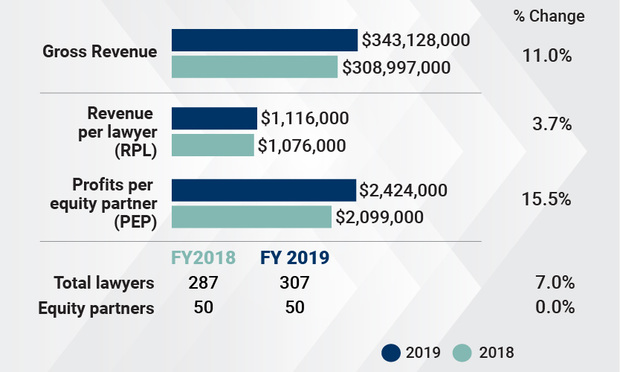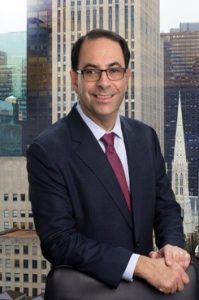Lowenstein's Earnings Spike Amid Gains in Head Count, Revenue Per Lawyer
Lowenstein Sandler posted year-over-year improvements in all financial metrics for fiscal 2019, including an 11% leap in gross revenue.
February 19, 2020 at 04:40 PM
5 minute read
Lowenstein Sandler posted year-over-year improvements in all financial metrics for fiscal 2019, including an 11% leap in gross revenue.
The revenue increase (to $343 million from $309 million) is fueled in part by considerable attorney head count growth, though revenue per lawyer, as well as other per-lawyer metrics, improved too.
Lowenstein, with its largest offices in Roseland and midtown Manhattan, has yet to crack the Am Law 200′s group of "first hundred" firms, though it is gaining ground and compares favorably to many of those firms in its metrics. It was 109th in gross revenue rankings last year.
"In and of itself, that is not a goal," managing partner Gary Wingens said of a possible vault into the first hundred in the coming years. But, he added, "in order to continue to attract really good lawyers at every level, we have to be able to be competitive in the types of metrics" that the Am Law 200 tracks.
 Lowenstein Sandler financials/illustration by ALM
Lowenstein Sandler financials/illustration by ALMOver a five-year period, the firm's gross revenue has grown roughly 49%, from $230 million in fiscal 2014.
The firm's head count (measured by average full-time equivalents for the year) was 307 in 2019. That's a 7% increase and net gain of 20 full-time equivalents from 2018.
In terms of raw head count, the firm had 351 total lawyers at year's end, compared with 325 at the end of 2018 and 291 at the end of 2017, Wingens noted.
Last year was a "very active recruiting year," though lateral hires were "virtually all individual additions," he said. "We needed a lot more people to do the work."
That work included what Wingens said was a record-setting 2019 for the number of investment fund launches that Lowenstein advised, as well as banner years in venture capital, private equity and M&A deals.
"We've been launching funds for some of the country's largest hedge funds and private equity funds for quite some time. In recent years we've really been building our market share among what we'd call well-pedigreed fund launches," meaning funds launched by former managers of well-established funds, often with financial backing from those well-established funds, he said.
Also, the firm's bankruptcy practice, which accounts for slightly less than 10% of the firm's attorney head count but more than 10% of gross revenue, according to Wingens, had an active year, he said, noting the Bumblebee, Barneys and Fred's stores bankruptcies as examples.
 Gary Wingens
Gary WingensLowenstein's highest-value M&A deals of 2019—representing Indorama Ventures in its $2 billion acquisition of Huntsman's specialty chemicals portfolio, and Estée Lauder's $1.7 billion acquisition of Have & Be Co. Ltd.—were both cross-border deals that relied on help from the Washington, D.C.-based global trade practice the firm added in late 2018, Wingens said.
Head count growth certainly fueled revenue, but lawyers brought in more on an individual basis, too, in 2019. Revenue per lawyer increased by 3.7%, to $1.12 million, from $1.08 million. The $1.12 million RPL figure puts Lowenstein slightly ahead of the fiscal 2018 average for the first hundred ($975,982) and well ahead of the fiscal 2018 average for the second hundred ($667,513), according to ALM data.
And a 15.5% spike in profit per equity partner (PEP) puts that figure at $2.42 million. Again using fiscal 2018 figures from the 2019 Am Law 100 as a reference, Lowenstein's PEP figure is on par with that of first hundred firms Shearman & Sterling ($2.43 million) and Akin Gump ($2.4 million).
Lowenstein has had 50 equity partners in each of the last two years. That, combined with overall head count growth, means leverage (the ratio of all firm attorneys less equity partners to equity partners) increased. Stated simply, for every equity partner, there are more than five lawyers of another rank at Lowenstein.
Wingens noted that the firm actually has 70 equity partners per its partnership agreement, while 50 is the number of partners who receive majority equity compensation. Still, by either measure, it's "a high bar to become an equity partner" at the firm, Wingens said.
"There is no hard-and-fast rule … but your partners have to view you as really important to the future of the firm," he said. "We're not following a pure numbers game, but what we find is, when we make the right people partner, the work follows."
As for firms' varying leverage models, Wingens said there are "lots of different formulas for success."
"One thing we've seen in this industry is there's lots of room for different models," he said. "We are fortunate to have the kind of work that supports" many lawyers, he added.
Some 300 of Lowenstein's lawyers are equally distributed between the Roseland and Midtown Manhattan offices, with many attorneys splitting time. Wingens noted the "increasing mobility between the two offices," which he said is a point of recruiting these days, specifically the compensation parity among lawyers based in those locations.
"You're going to get the exact same work and make the same money" in either New York or New Jersey, is the message to recruits, according to Wingens.
This content has been archived. It is available through our partners, LexisNexis® and Bloomberg Law.
To view this content, please continue to their sites.
Not a Lexis Subscriber?
Subscribe Now
Not a Bloomberg Law Subscriber?
Subscribe Now
NOT FOR REPRINT
© 2025 ALM Global, LLC, All Rights Reserved. Request academic re-use from www.copyright.com. All other uses, submit a request to [email protected]. For more information visit Asset & Logo Licensing.
You Might Like
View All
Send Us Your New Partners for the NJ Law Journal's New Partners Yearbook
1 minute read
New Methods for Clients and Families to Have Their Estate and Legacy Planning Complete
5 minute read
Tensions Run High at Final Hearing Before Manhattan Congestion Pricing Takes Effect
4 minute readLaw Firms Mentioned
Trending Stories
- 1SDNY US Attorney Damian Williams Lands at Paul Weiss
- 2Litigators of the Week: A Knockout Blow to Latest FCC Net Neutrality Rules After ‘Loper Bright’
- 3Litigator of the Week Runners-Up and Shout-Outs
- 4Norton Rose Sues South Africa Government Over Ethnicity Score System
- 5KMPG Wants to Provide Legal Services in the US. Now All Eyes Are on Their Big Four Peers
Who Got The Work
Michael G. Bongiorno, Andrew Scott Dulberg and Elizabeth E. Driscoll from Wilmer Cutler Pickering Hale and Dorr have stepped in to represent Symbotic Inc., an A.I.-enabled technology platform that focuses on increasing supply chain efficiency, and other defendants in a pending shareholder derivative lawsuit. The case, filed Oct. 2 in Massachusetts District Court by the Brown Law Firm on behalf of Stephen Austen, accuses certain officers and directors of misleading investors in regard to Symbotic's potential for margin growth by failing to disclose that the company was not equipped to timely deploy its systems or manage expenses through project delays. The case, assigned to U.S. District Judge Nathaniel M. Gorton, is 1:24-cv-12522, Austen v. Cohen et al.
Who Got The Work
Edmund Polubinski and Marie Killmond of Davis Polk & Wardwell have entered appearances for data platform software development company MongoDB and other defendants in a pending shareholder derivative lawsuit. The action, filed Oct. 7 in New York Southern District Court by the Brown Law Firm, accuses the company's directors and/or officers of falsely expressing confidence in the company’s restructuring of its sales incentive plan and downplaying the severity of decreases in its upfront commitments. The case is 1:24-cv-07594, Roy v. Ittycheria et al.
Who Got The Work
Amy O. Bruchs and Kurt F. Ellison of Michael Best & Friedrich have entered appearances for Epic Systems Corp. in a pending employment discrimination lawsuit. The suit was filed Sept. 7 in Wisconsin Western District Court by Levine Eisberner LLC and Siri & Glimstad on behalf of a project manager who claims that he was wrongfully terminated after applying for a religious exemption to the defendant's COVID-19 vaccine mandate. The case, assigned to U.S. Magistrate Judge Anita Marie Boor, is 3:24-cv-00630, Secker, Nathan v. Epic Systems Corporation.
Who Got The Work
David X. Sullivan, Thomas J. Finn and Gregory A. Hall from McCarter & English have entered appearances for Sunrun Installation Services in a pending civil rights lawsuit. The complaint was filed Sept. 4 in Connecticut District Court by attorney Robert M. Berke on behalf of former employee George Edward Steins, who was arrested and charged with employing an unregistered home improvement salesperson. The complaint alleges that had Sunrun informed the Connecticut Department of Consumer Protection that the plaintiff's employment had ended in 2017 and that he no longer held Sunrun's home improvement contractor license, he would not have been hit with charges, which were dismissed in May 2024. The case, assigned to U.S. District Judge Jeffrey A. Meyer, is 3:24-cv-01423, Steins v. Sunrun, Inc. et al.
Who Got The Work
Greenberg Traurig shareholder Joshua L. Raskin has entered an appearance for boohoo.com UK Ltd. in a pending patent infringement lawsuit. The suit, filed Sept. 3 in Texas Eastern District Court by Rozier Hardt McDonough on behalf of Alto Dynamics, asserts five patents related to an online shopping platform. The case, assigned to U.S. District Judge Rodney Gilstrap, is 2:24-cv-00719, Alto Dynamics, LLC v. boohoo.com UK Limited.
Featured Firms
Law Offices of Gary Martin Hays & Associates, P.C.
(470) 294-1674
Law Offices of Mark E. Salomone
(857) 444-6468
Smith & Hassler
(713) 739-1250







